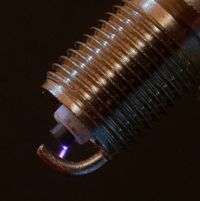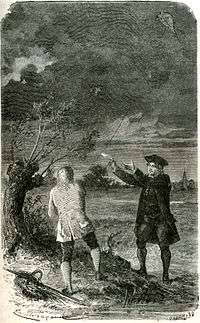Electric spark

An electric spark is an abrupt electrical discharge that occurs when a sufficiently high electric field creates an ionized, electrically conductive channel through a normally-insulating medium, often air or other gases or gas mixtures.
The rapid transition from a non-conducting to a conductive state produces a brief emission of light and a sharp crack or snapping sound. A spark is created when the applied electric field exceeds the dielectric breakdown strength of the intervening medium. For air, the breakdown strength is about 30 kV/cm at sea level.[1] At the beginning stages, free electrons in the gap (from cosmic rays or background radiation) are accelerated by the electrical field. As they collide with air molecules, they create additional ions and newly freed electrons which are also accelerated. The exponentially-increasing electrons and ions rapidly cause regions of the air in the gap to become electrically conductive in a process called dielectric breakdown. Once the gap breaks down, current flow is limited by the available charge (for an electrostatic discharge) or by the impedance of the external power supply. If the power supply continues to supply current, the spark will evolve into a continuous discharge called an electric arc. An electric spark can also occur within insulating liquids or solids, but the breakdown mechanisms are significantly different than for sparks in gases.
Lightning is an example of an electric spark in nature, while electric sparks, large or small, occur in or near many man-made objects, both by design and sometimes by accident.
History

Around 600 BC, Greek philosopher Thales of Miletus observed that amber could be electrified when rubbed with a cloth and attract other objects and produce sparks. In 1671, Leibniz discovered that sparks were associated with electrical phenomena.[2] In 1708, Samuel Wall performed experiments with amber rubbed with cloth to produce sparks.[3] In 1752, Thomas-François Dalibard and Benjamin Franklin independently demonstrated that lightning and electricity were equivalent. In Franklin's famous kite experiment, he successfully extracted sparks from a cloud during a thunderstorm.
Uses
Ignition sources

Electric sparks are used in spark plugs in gasoline internal combustion engines to ignite fuel and air mixtures.[4] The electric discharge in a spark plug occurs between an insulated central electrode and a grounded terminal on the base of the plug. The voltage for the spark is provided by an ignition coil or magneto that is connected to the spark plug with an insulated wire.
Flame igniters use electric sparks to initiate combustion in some furnaces and gas stoves in place of a pilot flame.[5] Auto reignition is a safety feature that is used in some flame igniters that senses the electrical conductivity of the flame and uses this information to determine whether a burner flame is lit.[6] This information is used to stop an ignition device from sparking after the flame is lit or restart the flame if it goes out.
Radio communications

A spark-gap transmitter uses an electric spark gap to generate radio frequency electromagnetic radiation that can be used as transmitters for wireless communication.[7] Spark gap transmitters were widely used in the first three decades of radio from 1887–1916. They were later supplanted by vacuum tube systems and by 1940 were no longer used for communication. The wide use of spark-gap transmitters led to the nickname "sparks" for a ship's radio officer.
Metalworking
Electric sparks are used in different kinds of metalworking. Electric discharge machining (EDM) is sometimes called spark machining and uses a spark discharge to remove material from a workpiece.[8] Electrical discharge machining is used for hard metals or those that are difficult to machine with traditional techniques.
Spark plasma sintering (SPS) is a sintering technique that uses a pulsed direct current that passes through an conductive powder in a graphite die.[9] SPS is faster than conventional hot isostatic pressing, where the heat is provided by external heating elements.

In welding, a continuous electric spark melts metal. The heat generated by the continuous current is used to join the two metal parts.
Chemical analysis
The light that is produced by electric sparks can be collected and used for a type of spectroscopy called spark emission spectroscopy.[10]
A high energy pulsed laser can be used to produce an electric spark. Laser induced breakdown spectroscopy (LIBS) is a type of atomic emission spectroscopy that uses a high pulse energy laser to excite atoms in a sample. LIBS has also been called laser spark spectroscopy (LSS).[11]
Electric sparks can also be used to create ions for mass spectrometry.[12]
See also
References
- ↑ Meek, J. (1940). "A Theory of Spark Discharge". Physical Review. 57 (8): 722. Bibcode:1940PhRv...57..722M. doi:10.1103/PhysRev.57.722.
- ↑ Kryzhanovsky, L. N. (1989). "Mapping the history of electricity". Scientometrics. 17: 165. doi:10.1007/BF02017730.
- ↑ Heilbron, J. L.; Heilborn, J. L. (1979). Electricity in the 17th and 18th centuries: a study of early Modern physics. Berkeley: University of California Press. ISBN 0-520-03478-3.
- ↑ The Bosch book of the Motor Car, Its evolution and engineering development, St. Martin's Press, copyright 1975, Library of Congress # 75-39516, pp 206-207.
- ↑ Bill Whitman; Bill Johnson; John Tomczyck (2004). Refrigeration and Air Conditioning Technology, 5E. Clifton Park, NY: Thomson Delmar Learning. pp. 677ff. ISBN 1-4018-3765-4.
- ↑ Ed Sobey (2010). The Way Kitchens Work: The Science Behind the Microwave, Teflon Pan, Garbage Disposal, and More. Chicago, Ill: Chicago Review Press. p. 116. ISBN 1-56976-281-3.
- ↑ Beauchamp, K. G. (2001). History of telegraphy. London: Institution of Electrical Engineers. ISBN 0-85296-792-6.
- ↑ Jameson, Elman C. (2001). Electrical discharge machining. Dearborn, Mich: Society of Manufacturing Engineers. ISBN 0-87263-521-X.
- ↑ Munir, Z. A.; Anselmi-Tamburini, U.; Ohyanagi, M. (2006). "The effect of electric field and pressure on the synthesis and consolidation of materials: A review of the spark plasma sintering method". Journal of Materials Science. 41 (3): 763. Bibcode:2006JMatS..41..763M. doi:10.1007/s10853-006-6555-2.
- ↑ Walters, J. P. (1969). "Historical Advances in Spark Emission Spectroscopy". Applied Spectroscopy. 23 (4): 317. Bibcode:1969ApSpe..23..317W. doi:10.1366/000370269774380662.
- ↑ Radziemski, Leon J.; Cremers, David A. (2006). Handbook of laser-induced breakdown spectroscopy. New York: John Wiley. ISBN 0-470-09299-8.
- ↑ Dempster, A. J. (1936). "Ion Sources for Mass Spectroscopy". Review of Scientific Instruments. 7: 46. Bibcode:1936RScI....7...46D. doi:10.1063/1.1752028.
External links
| Wikimedia Commons has media related to Electric sparks. |
- Szikrakisülés (1)...(4) Electric spark (1)...(4). Videos on the portal FizKapu (Hungarian).